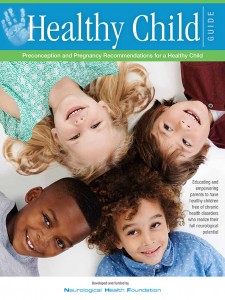
Healthy Child Guide for Preconception and Pregnancy outlines risk-reduction strategies
Joint Project of ASU and Neurological Health Foundation

Healthy Child Guide for Preconception and Pregnancy
The Neurological Health Foundation and Arizona State University today released the Healthy Child Guide – Preconception and Pregnancy Recommendations for a Healthy Child. The 50-page guide provides families with many simple and safe suggestions on how to substantially reduce the risk of pregnancy/birth complications, reduce the risk of many mental and physical health disorders, and improve children’s growth and development.
Approximately 30 percent of children in the U.S. suffer from serious neurological, developmental, psychiatric and physical health problems, including ADHD, autism, learning disabilities, asthma, and other serious medical conditions. Although there is extensive research demonstrating how to substantially reduce those risks, that information is not reaching physicians and families.
To create the Healthy Child Guide, the Neurological Health Foundation teamed up with ASU President’s Professor James B. Adams, a materials science and engineering faculty member in the Fulton Schools. Adams, who also is Director of the Autism/Asperger’s Research Program at ASU, assembled a national scientific advisory board, including a team of expert physicians, nutritionists, toxicologists and researchers, who spent two years researching and developing the Healthy Child Guide. The team also compiled a companion document for physicians and interested families, Science Behind the Healthy Child Guide, which summarizes the research behind the recommendations.
The Healthy Child Guide is divided into several major sets of recommendations, including nutrition, prenatal supplements, reducing toxic exposures, individualized medical testing and treatment, and exercise. For example, just one recommendation of taking a prenatal supplement prior to or at conception, instead of two or three months later, can reduce the risk of autism by roughly 40 percent.
“My hope is that the Healthy Child Guide will help many families have a healthy child,” says Prof. Adams. “One of my daughters was diagnosed with autism 20 years ago, and I wish I could have prevented that. Today’s healthcare system spends far too much on treating serious health problems, and not nearly enough on how to prevent them.”
“Many chronic childhood diseases, including neurodevelopmental disorders such as autism, have no effective treatments or cures and affect far too many children,” says Richard E. Frye, M.D., Ph.D., Director of the Autism Program at Arkansas Children’s Hospital. “It is becoming clear that very simple changes in lifestyle, diet and nutrition may be effective in preventing these disorder from occurring. Not only are prevention strategies much more cost-effective, they can significantly improve the quality of life for the child as well as the family. Many of the guidelines improve general health as well as potentially improve child development. In addition, given that effective treatments and cures are not available for many childhood diseases, one of the only ways to combat these diseases is to prevent them.”
“NHF is proud to offer to both the general public and the medical community the opportunity to learn about the scientific research that supports the recommendations in The Healthy Child Guide. Everyone on NHF’s leadership team is looking forward to the positive impact this program will have on the lives of many, many children.” Chris Willhite, CEO of the Neurological Health Foundation.
The Healthy Child Guide, and The Science Behind the Healthy Child Guide, are available at no cost from the Neurological Health Foundation.



































